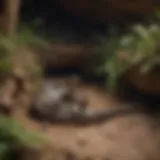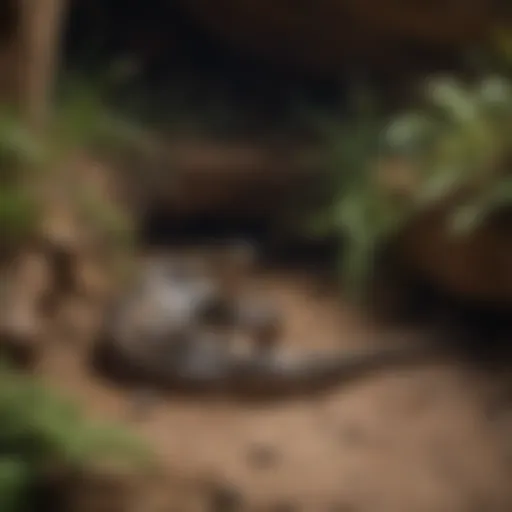Effective Sprays and Methods for Preventing Wasp Infestations
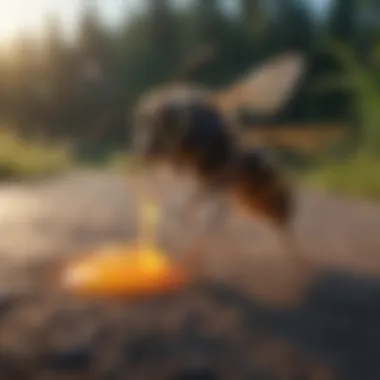

Preventive Pest Control Strategies
When it comes to preventing wasp infestations, implementing proactive pest control strategies is paramount. Starting with house exterior protection, sealing cracks and crevices is essential to prevent any entry points for pests. Clearing debris around the property is equally important as it eliminates potential nesting sites for wasps. Additionally, taking measures to prevent pests from entering the home through gaps in windows or doors can significantly reduce the risk of infestations.
In terms of yard maintenance, establishing essential yard care routines such as regular mowing and trimming vegetation can help keep the yard pest-free. Utilizing methods like removing standing water and addressing overgrown plants can also discourage wasps from establishing colonies near the home. Moreover, maintaining indoor cleanliness plays a crucial role in pest prevention. Implementing expert cleaning tips and techniques, such as regular vacuuming and proper food storage, can create a pest-resistant indoor environment.
Efficient garbage disposal methods are another key aspect of preventive pest control. Proper waste disposal not only helps in managing wasp populations attracted to food sources but also minimizes the risk of other pest infestations. Emphasizing the importance of disposing of trash promptly and in bins with secure lids can significantly contribute to a pest-free environment.
Furthermore, exploring other pest prevention strategies can provide innovative ways to safeguard your home against various types of pests. Incorporating strategies like using natural deterrents and installing barriers can add layers of protection against wasps and other nuisance insects, enhancing the overall pest control efforts in and around the property.
Identifying Pest Risk Areas
To effectively prevent wasp infestations, it is critical to identify potential pest risk areas within and around the property. Conducting inspections in moisture-prone areas can help in recognizing damp conditions that attract pests like wasps. Implementing tips for preventing infestations, such as fixing leaking pipes and improving ventilation, can help in minimizing the risk of pest problems.
Inspection of crack and crevices is equally important in pest risk assessment. Identifying access points for pests and sealing them using appropriate methods can prevent wasps from gaining entry into the home. Regular maintenance and inspections can aid in early detection of potential problem areas, enabling timely intervention to mitigate infestation risks.
Moreover, evaluating greenery for pest risks is essential in preventing wasp colonies from forming near the property. Understanding the impact of landscaping on pest attraction and implementing guidelines to maintain a pest-free yard can significantly reduce the likelihood of wasp infestations. Additionally, addressing other pest risk areas, such as storage spaces and compost bins, through preventive measures can enhance overall pest control efforts.
Effective Pest Control Methods
Incorporating effective pest control methods is instrumental in managing and deterring wasp infestations successfully. Utilizing natural repellents like essential oils, herbs, and plants can help in repelling wasps without harming the environment. Implementing safe usage of professional chemical sprays can eradicate existing pest populations and prevent further infestations when applied correctly.
Pest traps also serve as effective pest control solutions for managing wasps. Setting up traps in strategic locations can capture and remove pests safely, reducing the overall population around the property. Biological control methods, such as introducing natural predators like certain bird species or insects, can offer environmentally-friendly pest management solutions that target specific pest species.
Exploring other pest control methods beyond traditional options can provide additional avenues for managing wasp infestations. Innovations in pest control, such as ultrasonic devices or smart repellent systems, offer alternative approaches to deterring pests effectively while minimizing environmental impact.
Pest Species Identification
Identifying common pest species is crucial in developing targeted pest prevention strategies. Recognizing common insects like ants, cockroaches, and spiders allows for tailored pest control measures that address specific behaviors and nesting habits. Understanding the signs of rodent presence and types of rodents, such as mice and rats, enables homeowners to take proactive measures to prevent infestations.
Bird species impacting home environments can also pose challenges that require specific interventions. Addressing bird-related issues, such as nesting in roof eaves or causing property damage, may involve using deterrents or altering the environment to discourage nesting. Additionally, dealing with wildlife encounters, whether raccoons, squirrels, or other wildlife, requires a nuanced approach that balances humane treatment with property protection.
Furthermore, identifying and managing lesser-known pest species effectively contributes to comprehensive pest control efforts. Taking the time to learn about lesser-known pests, their habits, and habitat preferences can help in implementing targeted control measures to prevent infestations and maintain a pest-free environment.


DIY Pest Control Techniques
Incorporating do-it-yourself (DIY) pest control techniques offers homeowners cost-effective and eco-friendly options for managing pests like wasps. Creating homemade pest control solutions using common household ingredients can provide effective protection against pests without the need for harsh chemicals. Utilizing essential oils for pest control serves as a natural and pleasant way to repel insects, including wasps, while creating a fragrant and bug-free home environment.
Setting up effective pest traps and barriers using readily available materials can aid in controlling and preventing pest infestations on the property. Investing in top reputable pest control brands can offer specialized products that cater to specific pest control needs, ensuring high-quality and reliable pest management solutions. Exploring miscellaneous DIY pest control techniques, such as using diatomaceous earth or eco-friendly repellents, can provide homeowners with a diverse range of options for addressing different pest issues.
Understanding Wasp Behavior
In this comprehensive guide on preventing wasp infestations, understanding wasp behavior plays a pivotal role. By delving deep into the intricacies of how wasps behave, we can identify patterns and habits that allow us to better manage and prevent infestations effectively. Recognizing the lifecycle of wasps and understanding common wasp species are fundamental in devising successful prevention strategies. This section aims to shed light on the behaviors of these stinging insects, providing vital insights for tackling infestations with precision and efficacy.
Lifecycle of Wasps
The role of the queen wasp: The queen wasp serves as the centerpiece of a wasp colony, laying eggs and governing the hierarchy within the nest. Her role in reproduction and sustenance of the colony is unparalleled, dictating the growth and stability of the population. The queen's dominance ensures the survival of the species and orchestrates the functions of the entire colony, making her a quintessential figure in understanding wasp behavior for effective control measures. Despite her significance, the queen's presence also signifies vulnerability, as her removal can destabilize the colony and trigger defensive responses.
Development of colonies: The development of colonies signifies the expansion and organization of a wasp population under the reign of the queen. From initial nest construction to the maturation of worker wasps, the development process is intricate yet impactful. Understanding the stages of colony growth allows us to anticipate infestation patterns and intervene with targeted strategies. While the establishment of colonies showcases the resilience and adaptability of wasps, it also underscores the need for proactive prevention methods to curb their proliferation effectively.
Common Wasp Species
Yellow jackets: Yellow jackets, notorious for their aggressive nature, pose a significant threat to human environments. Their ability to build nests in various locations and swarm in response to perceived threats makes them challenging to handle. Despite their predatory behavior, these wasps play a vital ecological role in pest control, preying on insects that can harm crops and gardens. Utilizing specific repellents and deterrents tailored to yellow jackets is paramount in mitigating their presence and safeguarding against potential encounters.
Paper wasps: Paper wasps, known for their distinctive paper-like nests, exhibit less aggression compared to yellow jackets but can still pose risks near inhabited areas. Their nesting habits on eaves and ledges require targeted prevention methods to inhibit nest development successfully. Understanding the behavior of paper wasps is crucial in preemptively addressing nest formations and minimizing confrontations. Implementing preventive measures that disrupt their nest-building process is key to discouraging paper wasp infestations effectively.
Hornets: Hornets, characterized by their large size and potent sting, instill fear in many due to their intimidating presence. Their aerial nests and territorial tendencies demand careful consideration when crafting prevention strategies. Hornets' importance in controlling other insect populations underscores the balance they bring to ecosystems while emphasizing the need for selective intervention to manage their impact near human dwellings. Employing specialized treatments tailored to hornets ensures a harmonious coexistence while safeguarding against potential encounters.
Identifying Wasp Nests
In the realm of preventing wasp infestations, identifying wasp nests plays a paramount role. Understanding the locations where these nests may be situated is crucial in effectively managing and controlling these stinging insects. By recognizing the signs of a potential nest, individuals can take proactive measures to address the issue before it escalates, ensuring a safe and harmonious environment free from the threat of wasp infestations.
Location of Nests
In-ground nests
Delving into the specifics of in-ground nests unveils a captivating aspect of wasp behavior. These nests, typically found beneath the earth's surface, offer a strategic advantage for certain wasp species due to their concealment and protection. The key characteristic of in-ground nests lies in their stealthy nature, making them an attractive option for wasps seeking a secure habitat. Despite their hidden presence, in-ground nests can pose challenges in detection and removal, requiring meticulous observation and handling to effectively combat wasp infestations.
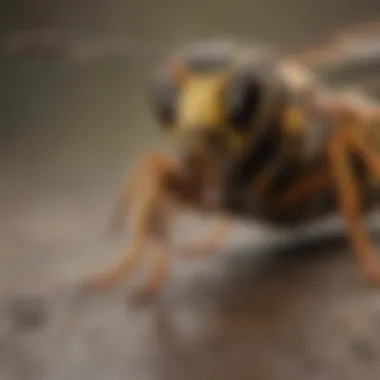

Aerial nests
Turning our focus to aerial nests sheds light on another intriguing facet of wasp nesting behavior. Suspended in the air, these nests showcase the architectural marvels crafted by wasps, highlighting their adaptability and resourcefulness. The primary allure of aerial nests stems from their accessibility to the insects while offering a level of visibility that aids in nest identification. However, the exposed nature of aerial nests also exposes them to external threats and disturbances, necessitating prompt action to prevent potential risks associated with these conspicuous structures.
Signs of Nest Presence
Exploring the signs of nest presence unravels vital indicators that can alert individuals to the proximity of wasp nests. Increased wasp activity serves as a prominent signal, signaling a surge in wasp movement and behavior around a particular area. Understanding the patterns of increased wasp activity enables proactive measures to be taken, mitigating the risk of potential confrontations with these territorial insects.
Wasp swarming represents another noteworthy sign of nest presence, highlighting the coordinated movements of wasps congregating near their nest site. This behavior not only indicates the proximity of a nest but also underscores the defensive nature of wasps when safeguarding their colony. By recognizing the patterns of wasp swarming, individuals can strategically navigate around these areas to avoid disturbance and potential harm, enhancing overall safety within their surroundings.
Effective Prevention Strategies
In the realm of preventing wasp infestations, effective prevention strategies play a pivotal role in maintaining a harmonious environment. By focusing on proactive measures, individuals can significantly reduce the risk of wasp colonies taking residence near their homes. The core essence of effective prevention strategies lies in thwarting potential infestations before they escalate, safeguarding property and well-being. Key elements of effective prevention methods include the use of natural repellents, commercial sprays, and sealing entry points to fortify barriers against invading wasps.
Natural Wasp Repellents
Peppermint oil spray
Peppermint oil spray stands out as a potent natural remedy in deterring wasps due to its strong aromatic properties that repel these insects effectively. The refreshing scent of peppermint not only wards off wasps but also serves as a non-toxic alternative, creating a safe environment devoid of harmful chemicals. The key characteristic of peppermint oil spray lies in its ability to disrupt the communication system of wasps, causing them to veer away from the treated area. Its natural composition makes it an environmentally friendly choice for those seeking sustainable pest control solutions. While peppermint oil spray boasts impressive efficacy in repelling wasps, its drawback may be its transient nature, requiring more frequent reapplications compared to chemical sprays.
Lemon and clove mixture
Known for its dual function in repelling both wasps and mosquitoes, the lemon and clove mixture offers a versatile approach to pest control. Its combination of citrusy notes and the strong aroma of clove creates a potent repellent that deters wasps effectively. The key characteristic of this mixture lies in its ability to target multiple types of pests, providing a comprehensive solution to household infestations. Furthermore, the natural ingredients in the lemon and clove mixture make it a safer option for families, minimizing potential health risks associated with chemical products. Despite its efficacy in repelling wasps, one downside of this mixture may be its limited reach compared to aerosol sprays, necessitating strategic placement around vulnerable areas to maximize effectiveness.
Commercial Wasp Sprays
Pyrethrin-based sprays
Pyrethrin-based sprays such as pyrethrum are derived from chrysanthemum flowers and are renowned for their rapid knockdown effect on insects like wasps. The key characteristic of these sprays is their quick action upon contact with pests, delivering immediate results in eliminating wasp threats. Their effectiveness in targeting specific pests while posing minimal harm to humans and pets makes them a preferred choice for quick and efficient wasp control. One unique feature of pyrethrin-based sprays is their biodegradable nature, aligning with eco-conscious practices. However, a potential disadvantage lies in their short residual activity, requiring frequent reapplication to maintain protection.
Deltamethrin aerosols
Deltamethrin aerosols represent a powerful commercial solution for combating wasp infestations, offering long-lasting residual control. The key characteristic of these aerosols is their formulation with synthetic pyrethroids, making them highly effective in killing wasps on contact and creating a deterrent barrier against future incursions. Their residual activity ensures prolonged protection, reducing the need for frequent reapplications. A unique feature of deltamethrin aerosols is their versatility in targeting various insect pests, making them a versatile tool in integrated pest management. Despite their efficacy, one drawback of these aerosols may be their chemical composition, necessitating cautious use in households with sensitive individuals.
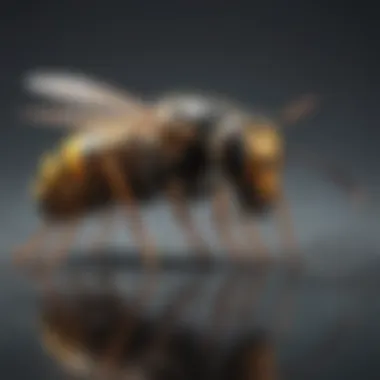

Sealing Entry Points
Inspecting potential entryways
Inspecting potential entryways for wasps plays a crucial role in fortifying defenses against infestations by identifying vulnerable points of entry. The key characteristic of this preventive measure lies in its proactive nature, enabling homeowners to preemptively seal off avenues that could allow wasps to infiltrate properties. Regular inspections of common entry points such as gaps in siding, vents, and utility penetrations are essential for minimizing the risk of infestations. By scrutinizing these areas for signs of wasp activity, individuals can take timely action to prevent incursions, fostering a pest-free environment.
Applying caulk or mesh barriers
Applying caulk or mesh barriers to entry points offers a physical deterrent against invading wasps, sealing off potential access routes and disrupting their ingress. The key characteristic of this method lies in its effectiveness in creating barriers that inhibit wasp penetration, reducing the likelihood of nests being established within structures. By applying caulk to cracks and crevices or installing mesh screens over vents and openings, individuals can reinforce their defense mechanisms against pest intrusions. One unique feature of using caulk or mesh barriers is their durability and long-lasting protection, providing a sustainable solution to fortifying homes against wasp infestations. However, one drawback of this approach may be the labor-intensive nature of installation, requiring meticulous attention to detail to ensure a secure seal.
Professional Wasp Control Services
In the realm of prevention strategies against wasp infestations, Professional Wasp Control Services stand out as a crucial element in ensuring thorough management of these stinging insects in domestic spaces. Bringing in experts to handle wasp infestations can provide a more effective and lasting solution compared to DIY approaches. These professionals are equipped with the knowledge, tools, and experience to tackle nests efficiently, minimizing the risks associated with wasp colony disruptions.
Benefits of Hiring Experts
Thorough Nest Removal
The meticulous process of thorough nest removal carried out by these professionals is a standout feature that contributes significantly to the overarching goal of this article. This approach involves the complete extraction of the nest, including the queen wasp, larvae, and worker wasps. By targeting the source of the infestation, experts ensure that the problem is eradicated from its roots, preventing future colonies from re-establishing in the same location.
Thorough nest removal is favored for its effectiveness in eliminating current infestations and deterring future ones. The meticulous nature of this process ensures that no remnants are left behind, reducing the likelihood of secondary infestations. Providing a long-term solution, thorough nest removal is a popular choice for households seeking sustainable wasp control methods.
Preventive Maintenance
Another integral aspect of Professional Wasp Control Services is preventive maintenance. This proactive approach involves identifying potential nesting sites, sealing off entry points, and implementing deterrent measures to discourage future wasp activity. By focusing on prevention, experts help homeowners safeguard their properties against potential infestations, creating a more harmonious living environment.
Preventive maintenance offers a preemptive solution to wasp infestations, addressing vulnerabilities in the property that may attract these insects. By fortifying the premises and implementing strategic measures, professionals reduce the likelihood of infestations, saving homeowners from the distress and inconvenience associated with recurring wasp issues.
Cost Considerations
Factors Affecting Pricing
When considering Factors affecting pricing for Professional Wasp Control Services, it is crucial to weigh various elements that influence the overall cost of these specialized services. Factors such as the size of the infestation, the location of nests, and the level of expertise required can all impact the pricing structure. Additionally, emergency services or advanced treatments may incur higher costs due to the complexity of the situation.
Factors affecting pricing play a significant role in determining the affordability and value of professional services. By understanding these variables, homeowners can make informed decisions regarding the selection of services that align with their budgetary constraints while delivering effective results.
ROI of Professional Services
Evaluating the ROI of professional services in the context of wasp control highlights the benefits of investing in expert assistance. While the initial cost may seem higher than DIY alternatives, the long-term returns of professional services outweigh the expenses. The comprehensive approach taken by experts results in more thorough and lasting solutions, reducing the need for recurrent treatments and minimizing property damage.
The ROI of professional services lies in the enhanced peace of mind and security provided to homeowners. By entrusting the task to skilled professionals, individuals can rely on sustainable wasp control measures that prioritize safety and effectiveness, offering a valuable investment in maintaining a wasp-free environment.
